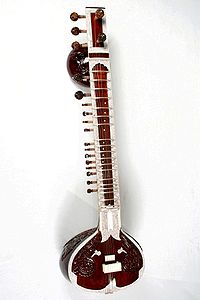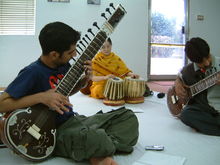Sitar
 | |
| Tipus | necked bowl lutes sounded by plectrum (en) |
|---|---|
| Classificació Hornbostel-Sachs | 321.321-6 |
| Epònim | setar |
| Originari de | Índia |
| Professió artística | sitarist (en) |

El sitar (en hindi सितार, sitār) és un instrument musical de corda indi, tradicional també al Pakistan, d'arquitectura similar a la de la guitarra i al banjo, tot i que la caixa de ressonància feta de carbassa és semiesfèrica i el mànec és més llarg i travessat per nombrosos trasts.[1][2] Segons la classificació Hornbostel-Sachs és un cordòfon compost del tipus llaüt amb mànec.
El sitar té de 18 a 26 cordes d'acer: 4 cordes per a la melodia, 3 que proporcionen l'acompanyament harmònic i rítmic, i entre 11 i 19 cordes afinables que vibren per simpatia i amb la seva ressonància donen cos i textura al so. Es pot identificar perquè té un so metàl·lic i pels seus glissandos. Totes les cordes són pinçades amb un plectre (mizrab)[3] situat al dit índex, menys les simpàtiques, que eventualment es toquen amb el dit petit. Els trasts que travessen el mànec són metàl·lics i mòbils, cosa que permet que l'instrument s'adapti a les diferents escales modals o ragues.[4]
El sitar és un instrument versàtil amb un so suau i brillant, apropiat per expressar el lent desenvolupament de les ragues així com per servir a la interpretació virtuosa. Es creu que va ser introduït a l'Índia des de Pèrsia durant el període mogol.[5][6]
Aquest instrument ha estat popularitzat a Occident en gran part gràcies al músic indi Ravi Shankar.[1]
Intèrprets de l'instrument
[modifica]- Vilayat Khan
- Imrat Khan
- Nikhil Banerjee
- Rais Khan
- Shahid Parvez
- Budhaditya Mukherjee
Intèrprets populars a occident
[modifica]- Ravi Shankar
- Anoushka Shankar
- George Harrison
- Brian Jones
- Ariel Ameijenda
Referències
[modifica]- ↑ 1,0 1,1 «Sitar». Gran Enciclopèdia Catalana. Barcelona: Grup Enciclopèdia Catalana.
- ↑ Junius, Manfred M.. The sitar : the instrument and its technique. Wilhelmshaven: Heinrichshofen, 1974. ISBN 3-7959-0173-1.
- ↑ Courtney, David.. Learning The Sitar Bkcd.. Mel Bay Publications Inc, 2009. ISBN 978-1-61065-256-8.
- ↑ "Sitar" a Gran Enciclopèdia de la Música. Barcelona: Enciclopèdia Catalana, 2002. ISBN 84-412-0239-7.
- ↑ de Hen, Ferdinand J. Indian musical instruments (en anglès, alemany i francès). Editions Mardaga, 2001, p. 20.
- ↑ Burgan, Michael.. Empires of ancient Persia. Nova York: Chelsea House, 2009. ISBN 978-1-4381-2784-2.
Text is available under the CC BY-SA 4.0 license; additional terms may apply.
Images, videos and audio are available under their respective licenses.
